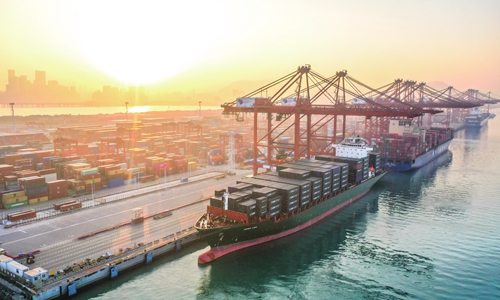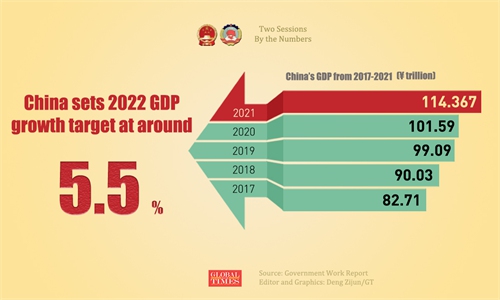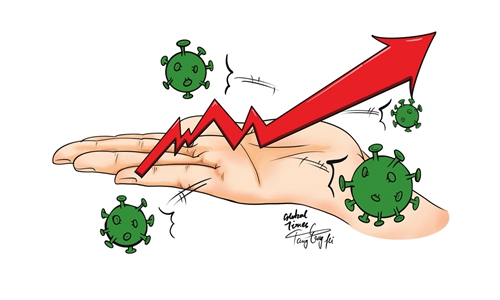
A freighter full of containers prepares to leave the port at the Dachanwan port container terminal in Shenzhen, South China's Guangdong Province, on January 21, 2022. Photo: cnsphoto
China is combating what is considered to be the most severe outbreak of COVID-19 yet, both in terms of daily infections and the number of affected areas across the country. On Monday, Chinese mainland reported 1,437 confirmed cases for Sunday, including 1,337 local infections. The number of new local confirmed cases has remained above 1,000 for the fourth consecutive day and the total number including asymptomatic cases exceeded 2,000 for the second straight day on Sunday.
That might just be the start of this new wave of outbreaks in China, according to one of the country's top infectious disease experts. Zhang Wenhong, head of the Center for Infectious Diseases with the Shanghai-based Huashan Hospital of Fudan University, wrote in a lengthy article on Sunday that this wave of the epidemic is "currently in the early stage of an exponential rise."
Meanwhile, many major cities and economic powerhouses responded to the new outbreaks rather swiftly and strictly. Changchun, the provincial capital of Northeast China's Jilin Province, with a population of 9.06 million and a GDP of 710.3 billion yuan ($111.6 billion), has been put under strict lockdown since Friday.
Shenzhen, the tech powerhouse in South China's Guangdong, with a GDP of 2.77 trillion yuan ($435.2 billion) and 17.6 million residents, has also imposed strict restrictions on movement. That has already affected many businesses based in the city, including a plant of Foxconn, as they were told to suspend operations.
Shanghai, which was widely praised for its effective responses to previous outbreaks, also appears to be facing a tough time in containing this new wave of COVID-19. On Monday, although local cases in the city were relatively low with a total of 45, the number of asymptomatic infections remained high at 164, which adds great pressure on the anti-epidemic efforts in the city.
The impact of the new outbreaks is not limited to a growing number of areas but in certain places, the impact is felt nationally. For example, numerous flights across the country have been canceled as part of the anti-epidemic efforts. Chinese railway authorities on Monday also rolled out measures for free ticket refunds.
While the economic tally of the anti-epidemic measures is hard to calculate due to a complex set of factors, there is no denying that the impact will be rather severe, particularly for those areas that have been put under lockdown. Even worse, the new outbreaks come as the Chinese economy is already facing pressure from various factors, including disruptions in supply chains, shrinking demand and weakening expectations, as identified by several top policy documents since the end of last year.
Such downward pressure was already obvious in the final quarter of 2021, when GDP growth slowed to 4 percent, the slowest pace since Q1 of 2020. In December, retail sales growth slowed sharply to 1.7 percent from 3.9 percent in the previous month.
Against such already worrisome trend, the new outbreaks in various major economic powerhouses across the country certainly spark even more concerns among investors, businesses and the public.
On Tuesday, China's main stock indexes saw sharp falls. The benchmark Shanghai Composite Index lost 2.61 percent, while the smaller Shenzhen Component Index dropped 3.03 percent. In Hong Kong, which is also battling a severe wave of the virus, the Hang Seng Index plunged by nearly 5 percent.
Obviously, challenges and risks for the Chinese economy are abundant. How to quickly rein in the spread of the virus while minimizing the economic costs is a real thorny question in front of policymakers. And let us not forget the escalating geopolitical tensions and economic warfare ignited by the US. Even as it has been focused on Russia, Washington has not stopped sanctions or threats of more sanctions against China.
Still, that does not mean the inevitable fall of the Chinese economy. Just as we should not underestimate the profound challenges and risks for the Chinese economy, we should not overlook its resilience and the effectiveness of the Chinese system in dealing with challenges and risks either. As proof of such resilience and effectiveness, one should look no further than China's robust recovery from the initial outbreak of COVID-19 in 2020.
What makes China's governance system stand out among major economic powers is its ability and efficiency in identifying problems and tackling them head-on. That is also the most reassuring thing in this rather difficult but critical period in China's economic development, and top officials have foreseen such difficulties and prepared sufficient policy tools to address them.
This year's government work report identified various challenges and risks, both at home and abroad including the COVID-19 pandemic, and accordingly formulated dozens of policy measures to ensure a stable growth with a target of around 5.5 percent for 2022. And that is no small thing, because China has never missed a growth target in all the years it has set official objectives.
The author is an editor with the Global Times. bizopinion@globaltimes.com.cn



